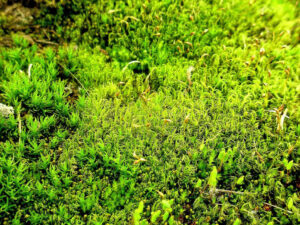Introduction to bryophyte dominated snowbeds
These areas of bryophyte-dominated vegetation occur in the highest Scottish mountains where snow lies late into the summer. They are a mix of greens, browns and reds and all shades in between and the contrast with the remaining snow and the surrounding bare gravels or scree is very attractive. They are wonderful places that have many uncommon species, including some that occur in no other habitat and should be on the itinerary of any discerning bryologist – our own little piece of the arctic.
Download the guide to snowbed habitats as a PDF
Snow accumulation
During the winter months the Scottish mountains have at least some of their precipitation as snow and general snow cover can persist for days and sometimes for many weeks on the highest hills. The Scottish mountains are windy and, as anyone who has been on a snowy Cairngorm Plateau or on the top of Ben Nevis in any kind of wind will know, snow does not stay where it falls. A big wind can shift prodigious amounts of snow, both fallen and falling, moving it from more exposed areas and onto lee slopes where large accumulations can occur. The depth and extent of these accumulations of wind-blown snow (snowbeds) depends on the catchment area, that is, the extent of the area, upwind of the snowbed, on which there is lying snow. The prevailing wind is usually from the west or south-west and so snowbeds tend to form on slopes with an east or north-east aspect and these are also the slopes on which insolation (solar radiation) is very limited or absent during much of the year. The Cairngorm plateau has by far the largest area of ground above 1000m in the UK and so provides an ideal catchment area and has numerous snowbeds. However, other high mountains also have snow-gathering ground and there are large and important snowbeds on the Ben Nevis – Aonach Mor range, on Ben Alder and on Creag Meaghaidh, with smaller sites on the bigger hills from Ben Lawers in the south to Beinn Dearg by Ullapool.
The stability of our general weather pattern and the very limited changes to the shape of the land over the relevant time scale means that these snowbeds tend to form in the same places each winter and that they are normally on slopes or in hollows with a north or north-easterly aspect. When the more general snow cover melts, these remnant snow patches are visible in much the same places year after year. The depth of accumulated snow and the limited insolation mean that these snowbeds last for much longer than the general snow cover and the most persistent snow usually remains as very large patches into July and some hollows and coires often retain a few small patches until the snows come again.
Snowbed vegetation
This persistent snow cover on these sites has an effect on the vegetation. The very short growing season means that vascular plants are at a disadvantage and have only a patchy presence here and the vegetation tends to be dominated by bryophytes with the addition of a significant lichen element on the drier soils and on the rocks. The National Vegetation Classification has a number of chionophilous (snow-loving) plant communities but the two main vegetation types on the bryophyte-dominated ground are the Polytrichum sexangulare – Kiaeria starkei snowbed (U11) and the Salix herbacea – Racomitrium heterostichum snowbed (U12). Also included within the vegetation described here are the more bryophyte-rich stands of the Carex bigelowii – Polytrichum alpinum sedge heath (U8) and the Deschampsia cespitosa – Galium saxatile grassland (U13).
A more detailed analysis of the U11 and U12 vegetation was carried out by Rothero in 1989 and 1990 and this maintained the Polytrichum sexangulare – Kiaeria starkei community, split off a Marsupella brevissima – Anthelia juratzkana community from U12 and described a Pohlia ludwigii community from the wetter areas in the snowbeds. These three plant communities occupy the areas where snow lasts longest, with the Polytrichum sexangulare – Kiaeria starkei tending to occur under the latest lying snow. These communities are very similar to those occurring in areas of late snow lie in Scandinavia.
Snowbed bryophytes
Bryophyte-dominated snowbed vegetation as described here is rare in the UK, perhaps covering only a few hundred hectares and it contains a number of nationally rare and scarce species and so is of considerable conservation interest. It has a number of species which have most or all of their Scottish records from within this vegetation and these are listed in the Snowbed bryophyte descriptions section below. This section also includes the conservation status of the species; almost all are on the UK Red List and one species is on Schedule 8 of the Wildlife and Countryside Act. However, it should also be realised that much of the cover in snowbed vegetation is provided by common, ruderal species like Nardia scalaris, Diplophyllum albicans, Cephalozia bicuspidata and Oligotrichum hercynicum.




